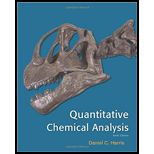
(a)
Interpretation:
The
Concept Information:
Conditional Formation Constant:
In the reaction of metal with ligand, the equilibrium constant is called as formation constant or the stability constant.
The formation constant for above complex reaction is,
Where,
Degree of dissociation:
The ratio of mole of reactant that underwent to dissociating to mole of initial reactant is known as degree of dissociation.
In EDTA the degree of dissociation is,
If pH is fixed, the degree of dissociation
Where,
Fraction of free metal ion:
In the metal ligand equilibria the number of moles of metal and ligand are equilibrium with number of mole of complex formed.
Where,
Fraction of free metal ion
Where,
(a)
Answer to Problem 12.16P
The
Explanation of Solution
To calculate the
Given,
End point is
Volume of
The complex formation reaction is,
At the give
The formation constant
Degree of dissociation
The Degree of dissociation
For
From the standard data,
To taking a log of above values,
Therefore,
The Degree of dissociation
We know,
The calculated
At
The calculated
The
The
(b)
Interpretation:
The
Concept Information:
Conditional Formation Constant:
In the reaction of metal with ligand, the equilibrium constant is called as formation constant or the stability constant.
The formation constant for above complex reaction is,
Where,
Degree of dissociation:
The ratio of mole of reactant that underwent to dissociating to mole of initial reactant is known as degree of dissociation.
In EDTA the degree of dissociation is,
If pH is fixed, the degree of dissociation
Where,
Fraction of free metal ion:
In the metal ligand equilibria the number of moles of metal and ligand are equilibrium with number of mole of complex formed.
Where,
Fraction of free metal ion
Where,
(b)
Answer to Problem 12.16P
The
Explanation of Solution
To calculate the
Given,
End point is
Volume of
The complex formation reaction is,
At the give
The formation constant
At
The volume difference is
The calculated concentration of
The
The
(c)
Interpretation:
The
Concept Information:
Conditional Formation Constant:
In the reaction of metal with ligand, the equilibrium constant is called as formation constant or the stability constant.
The formation constant for above complex reaction is,
Where,
Degree of dissociation:
The ratio of mole of reactant that underwent to dissociating to mole of initial reactant is known as degree of dissociation.
In EDTA the degree of dissociation is,
If pH is fixed, the degree of dissociation
Where,
Fraction of free metal ion:
In the metal ligand equilibrium, the number of moles of metal and ligand are equilibrium with number of mole of complex formed.
Where,
Fraction of free metal ion
Where,
(c)
Answer to Problem 12.16P
The
Explanation of Solution
To calculate the
Given,
End point is
Volume of
The complex formation reaction is,
At the give
The formation constant
At
The volume difference is
The calculated concentration of
The
The
(d)
Interpretation:
The
Concept Information:
Conditional Formation Constant:
In the reaction of metal with ligand, the equilibrium constant is called as formation constant or the stability constant.
The formation constant for above complex reaction is,
Where,
Degree of dissociation:
The ratio of mole of reactant that underwent to dissociating to mole of initial reactant is known as degree of dissociation.
In EDTA the degree of dissociation is,
If pH is fixed, the degree of dissociation
Where,
Fraction of free metal ion:
In the metal ligand equilibria the number of moles of metal and ligand are equilibrium with number of mole of complex formed.
Where,
Fraction of free metal ion
Where,
(d)
Answer to Problem 12.16P
The
Explanation of Solution
To calculate the
Given,
End point is
Volume of
The complex formation reaction is,
The calculated concentration of
The
The
(e)
Interpretation:
The
Concept Information:
Conditional Formation Constant:
In the reaction of metal with ligand, the equilibrium constant is called as formation constant or the stability constant.
The formation constant for above complex reaction is,
Where,
Degree of dissociation:
The ratio of mole of reactant that underwent to dissociating to mole of initial reactant is known as degree of dissociation.
In EDTA the degree of dissociation is,
If pH is fixed, the degree of dissociation
Where,
Fraction of free metal ion:
In the metal ligand equilibria the number of moles of metal and ligand are equilibrium with number of mole of complex formed.
Where,
Fraction of free metal ion
Where,
(e)
Answer to Problem 12.16P
The
Explanation of Solution
To calculate the
Given,
End point is
Volume of
The complex formation reaction is,
The calculated concentration of
The
The
Want to see more full solutions like this?
Chapter 12 Solutions
Quantitative Chemical Analysis 9e & Sapling E-Book and Homework for Quantitative Chemical Analysis (Six Month Access) 9e
 ChemistryChemistryISBN:9781305957404Author:Steven S. Zumdahl, Susan A. Zumdahl, Donald J. DeCostePublisher:Cengage Learning
ChemistryChemistryISBN:9781305957404Author:Steven S. Zumdahl, Susan A. Zumdahl, Donald J. DeCostePublisher:Cengage Learning ChemistryChemistryISBN:9781259911156Author:Raymond Chang Dr., Jason Overby ProfessorPublisher:McGraw-Hill Education
ChemistryChemistryISBN:9781259911156Author:Raymond Chang Dr., Jason Overby ProfessorPublisher:McGraw-Hill Education Principles of Instrumental AnalysisChemistryISBN:9781305577213Author:Douglas A. Skoog, F. James Holler, Stanley R. CrouchPublisher:Cengage Learning
Principles of Instrumental AnalysisChemistryISBN:9781305577213Author:Douglas A. Skoog, F. James Holler, Stanley R. CrouchPublisher:Cengage Learning Organic ChemistryChemistryISBN:9780078021558Author:Janice Gorzynski Smith Dr.Publisher:McGraw-Hill Education
Organic ChemistryChemistryISBN:9780078021558Author:Janice Gorzynski Smith Dr.Publisher:McGraw-Hill Education Chemistry: Principles and ReactionsChemistryISBN:9781305079373Author:William L. Masterton, Cecile N. HurleyPublisher:Cengage Learning
Chemistry: Principles and ReactionsChemistryISBN:9781305079373Author:William L. Masterton, Cecile N. HurleyPublisher:Cengage Learning Elementary Principles of Chemical Processes, Bind...ChemistryISBN:9781118431221Author:Richard M. Felder, Ronald W. Rousseau, Lisa G. BullardPublisher:WILEY
Elementary Principles of Chemical Processes, Bind...ChemistryISBN:9781118431221Author:Richard M. Felder, Ronald W. Rousseau, Lisa G. BullardPublisher:WILEY





